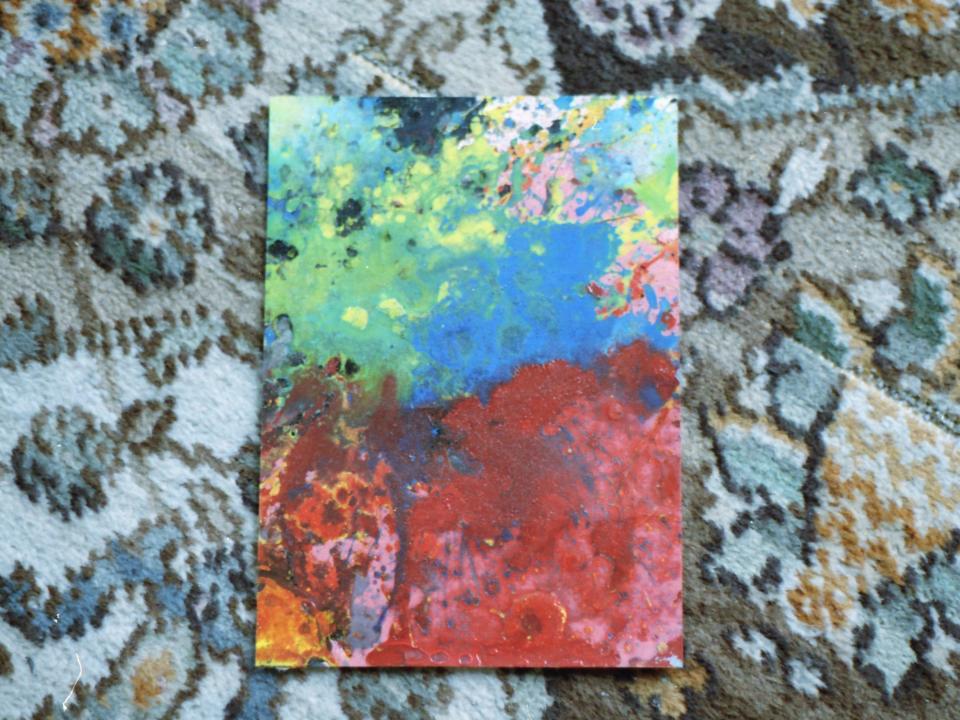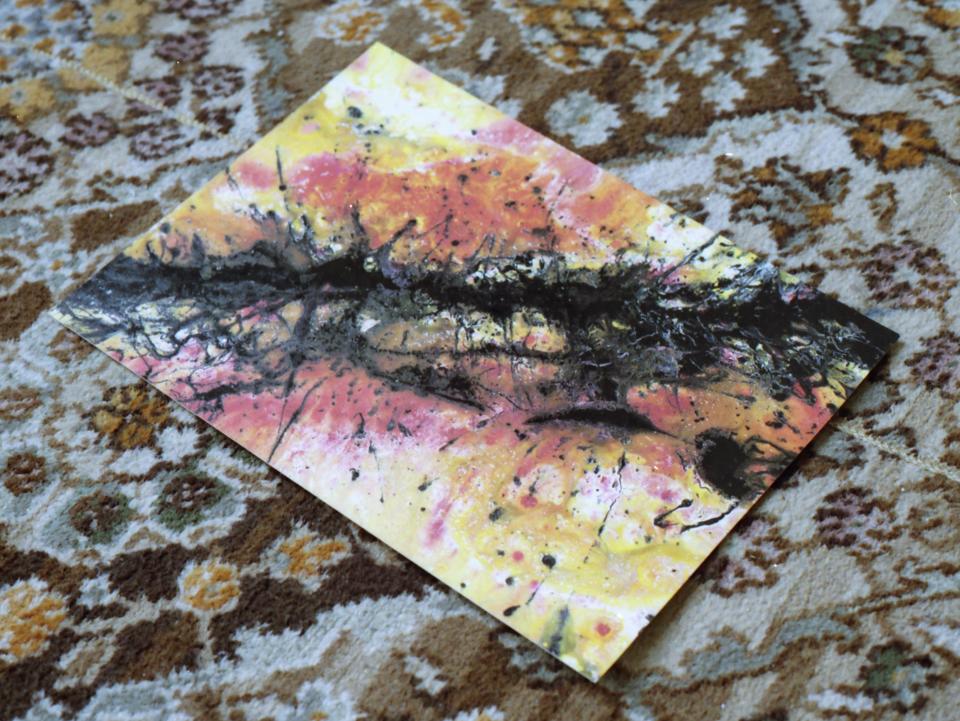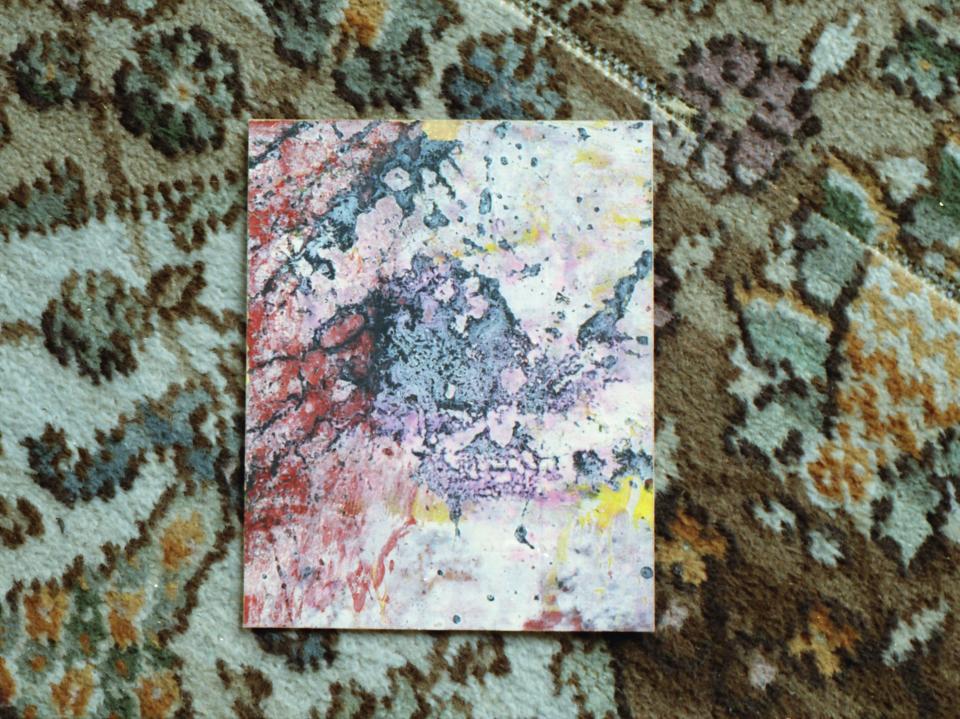Jack Coulter: Meet the young artist with synesthesia who 'hears' colour

‘1994’ by Jack Coulter, who creates his paintings in a tiny garage
(Jack Coulter)Jack Coulter’s art will grab you by the throat and demand your attention. It’s vivid, visceral and often inexplicably unsettling.
Coulter, 21, has a form of synesthesia, a rare neurological phenomenon that causes him to ‘hear’ colour, resulting in a sensory overload that he finds both draining and beautifully enriching. He has over 50,000 followers on Instagram and recently drew the attention of Mercury nominee SOAK, who requested to use his paintings for her album sleeve.
Here, he discusses how living with the condition affects his work, where his inspirations come from and how art can offer a way out from even the darkest times of despair.
How did you first realise you had synesthesia?
I have a specific memory of the sound of my own heartbeat resonating colour to me as a child. I was very young. I naively thought that it was just a normal part of growing up. I also had a recurring dream which still occurs to this day. It happens on the nights of heavy rainfall which hits my window, or any surface which resonates sound. Polychrome formations of colour surround me, which visually pulsate in time with each rain drop. It’s a bit insane, the recurring dream is in monochrome when I feel ill. It’s very complex, that’s why I became fascinated with oneirology [the study of dreams] to delve into my dream’s intricacies.
Was there a struggle to understand why others were not seeing what you were?
I remember when I was 11 my school teacher set a homework to draw from life and all the other students arrived in with perfectly drawn bowls of fruit and family portraiture. I had literally immersed my double page in colour. She simply said to me, “Have you always painted like that?” It really stayed with me; I painted life in my terms. I thought that I was going to get in trouble for expressing emotionality rather than representational means.
Could you describe synesthesia in more detail for those who might not have heard of the condition?
For those who do not have synesthesia, it’s very difficult to explain. It would be like trying to describe what the world looks like to an individual who has been blind from birth. Every person will interpret your articulations in a different way. It is difficult for us synesthetes to portray our visualisations and emotions in a clear manner as the variations differ from each individual. No one’s veins are identical and it’s exactly the same with synesthesia.
I have an idiosyncratic form of synesthesia; it differentiates vastly within experiential forms. If I feel emotionally stimulated within a specific situation, like staring at the sky or experiencing a sudden infatuation within a beautiful moment, my sight literally burns in fluorescence. That is an example of when my synesthesia is stimulated within experiential form. The dominance lays within my ability to ‘hear’ colour, which is known as chromesthesia or sound-to-colour synesthesia. I can vividly hear colours in prominence during the physical act of painting. My synesthesia emanates tetrachromatic hues of colour.

How do you cope with the sensory overload you experience every day?
The sensory overload affected me more so as a child. The recurring migraines were awful; I had one every single day. I was very hyper and therefore was experiencing a lot of new unexplained senses and emotions simultaneously. I am more conscious now as to what most stimulates my synesthesia. I think that was an important realisation as now I can avoid certain situations which would result in sensory overload. It still happens due to unfamiliar visual or emotional exposure. It is a constant form of visual pleasure. It is similar to life in that it is a continuous new form of discovery. I rarely have the exact same visual or cognitive experience. As I said earlier, it differentiates vastly within experiential form. I am constantly learning new things about myself, my cognitions and my artistry.
Do you see your condition as a gift, a burden, or both?
It can be very draining at times; the perpetual stimulation has left me in periods of disorientation yet other times words cannot describe how beautiful my experiences are. I don’t think that anything in life is either a gift or a burden. You can learn from all experiences, it’s very balanced. There are upsides, there are downsides. My synesthesia plays a strong part in my life as I’m an artist and my day-to-day being consists of stimulation in visual means.
Your artworks are psychedelic, vibrant and often disturbing. Can you tell me more about the creative process and how art serves as a form of therapy for you?
I work in my garage with literally no room, it’s hazardous. I love it. I paint with anything that I can find. I buy second-hand house paint and canvases from charity stores. I have never in my life used a paint brush; I find more freedom with unconventional tools such as sticks, knives and broken glass. Painting for me has always been a release, a way to mend my heart. My mum once said that I have paint circulating around my body instead of blood. Imagine bleeding different colours, that would be insane.
‘Art’ as an entity saved my life. I felt very frustrated growing up as I could not articulate my feelings, visualisations, emotions. If I hadn’t discovered the psychological release held within the complexities of the intricately illustrious mind, I may have been misguided into an artless, stifled, falsified existence. As a child, I was forever searching for an outlet to fill this gaping void in my chest. Everything changed once I discovered abstraction, I became addicted to painting.
You give aggressive titles to your pieces, from ‘cancer’ and ‘conscivit’ to ‘dysthymia’ and ‘glioma’. Could you explain more about these?
I explore the themes of love, death, birth, dreams, sex and anatomy within the confines of beauty. I desire the beautiful exterior of my paintings to be paralleled with an elusively harrowing interior. My intention is to expose the connotation of light within darkness in every sense. For example, cancer is the most vicious, devastating, deathly condition known to us. However, it is also a beautiful constellation in the sky; it’s a star sign for many individuals. I adore harsh contrasts. Conscivit is Latin for suicide. Dysthymia is a persistent depression. Glioma is a specific type of brain tumour arising from glial cells within the central nervous system. I also adore clear-cut beauty; I just find darkness the most fascinating. I want my paintings to provoke an introspective experience for the viewer, to delve into one’s interior rather than one’s exterior.

Your inspirations range from Jackson Pollock and Kurt Cobain to your own aunt. What is it about these people that you find so inspiring?
I think that it is naive to focus on just one sole entity as vast exposure is vital for any artist’s growth, I was brought up around abstract art. My aunt Christine was an abstract printmaker and I was strongly exposed to her work throughout my childhood. My mum had her work exhibited in every room of my house growing up, alongside works of post-war 1940s abstract expressionism. One of my earliest synesthetic experiences was during one of my aunt’s exhibitions as a child. I could ‘hear’ her paintings. It was a very strange yet beautiful experience. I lost my aunt to suicide the day before I began art college.
Certain post-war abstract expressionists such as Pollock, De Kooning, Kline, Newman, Still, Motherwell, Baziotes and Rothko are hugely inspiring to me; they were part of The Irascibles. The New York School is hugely influential to me and could not be more relevant in today’s culture. I could not stop crying at Pollock’s ‘Blind Spots’ exhibition; it just meant so much to me. I also adore impressionist painters such as Van Gogh, Cassatt, Morisot, Monet, Matisse. I could literally go on for hours.
Not a lot of individuals know that Kurt Cobain was a painter. Many of his family stated that they thought he would make it as a painter rather than a musician. His artistry was overlooked by how incredible the music was though you just have to look at his paintings, music videos and album covers to see what a special visual artist he was. It’s strange to think that he died just two weeks before I was born in April 1994.
Some of your posts feature typed up passages of text, either by you or others you admire.
I delve into all forms of expression, I use a vintage Olivetti typewriter for my thoughts, writings and poetry. I also compose my own original musical compositions and often paint to them. I am infatuated with ambience. I create a lot of video art with faded layered visuals and psychedelic, dream-like sequences. I use literature as a stream of self-analysis, almost fluent psychological findings which were previously dormant. It’s almost pure psychic automatism which as I have stated before is vital to my artistry. I admire many literary figures from the 1800s and always speak of how Rimbaud’s “Ophelia” once inspired me to begin a painting. Inspiration comes in all forms for me.
Synesthesia is often romanticised as a ‘creative genius’ condition. How do you feel about that?
It is a huge compliment when someone states that although it does not mean that I am ‘better’ than anyone else. I am just experiencing life through a heightened sense of iridescent form. It contributes to my artistry, as it does for all artists with synesthesia.

Some of your Instagram followers claim to have your paintings tattooed onto their bodies while others say your art has saved their lives. How does this affect you?
It’s crazy when someone gets my artwork tattooed on their body, one girl has my artwork tattooed on her neck. The whole online world is totally mad, I can’t deal with it sometimes. I once received a devastating message: a girl told me that she was about to commit suicide though seeing my art online changed her mind. I just couldn’t believe that a painting I created in my garage could save someone’s life. There’s a reason behind all of life’s moments.
I’ve had a lot of incredible moments regarding the power of art. I skipped college to buy my homeless friend Terry art supplies after he told me that he used to draw and paint when he was younger, though had to give it up. His life was falling apart. I then saw him weeks later when I was in a vintage store buying a camera with my mum, I couldn’t believe my eyes, he was a totally transformed person. He saw me and said, “Those art supplies you gave me changed my life, I am now enrolled in an art course in the city, I couldn’t be happier.”
I first met him in hospital. I was anorexic. My weight was dangerously low, I was having severe heart palpitations. When I look back on that time, it was scary. It brought back horrid memories for me of when I was 12 and almost died of severe alcohol poisoning. It was an awful point in my young life. I was also experimenting a lot with drugs, trying to fill a void. If someone reading this is experiencing a dark period, I just want you to know that it will all make sense one day. Just hold on.
Is it true that Samuel L Jackson and Keith Richards are fans of your paintings?
Each celebrity winner at the GQ Men Of The Year Awards 2015 was given an exclusive print of my artwork. It’s insane to think that so many celebrities own a print of my work, especially Keith Richards. My mum loves The Rolling Stones so she was pretty proud. I was still finishing college when a lot of the most famous individuals were receiving my art, ironic as I was given a third-class honours in my college degree show. Damien Hirst also received a third-class in his degree show, so I’m in good company.
I don’t believe in celebrity culture - it’s a dangerous, empty, unfulfilling concept. The media controls the nation. There are catastrophic events happening in the world yet the media focuses on a celebrity not wearing make up while buying a pint of milk. It is dehumanising. Celebrity culture is a drug to the unconscious mind, it distracts us from what is truly important.
You provided artwork for singer-songwriter SOAK’s Mercury nominated debut album. How did that come about?
SOAK (real name Bridie) chose six of my images for Before We Forgot How to Dream. Her music is very dream-like and heavily seeped in emotionality. In visual means, my artwork is of a similar nature. She was very persistent in using specific images of mine so they must have been particularly visceral for her. The overall sound of her album, especially songs like “A Dream to Fly”, resonate harsh bleeds of colour fades to me, similar to Monet’s Water Lilies series. She is a genius, releasing an album of that purity at only 18 is rare. Most musicians her age are being told what to do in every sense of their career, she is the truth. I feel very lucky to be working with her.

Do you have future plans?
I’m a very shy, sensitive, insecure person. I am also very open and very in touch with emotionality. I will always lay my heart on the line, it’s just who I am. It’s strange, I don’t want to look back on my life thinking “What if…”. I also don’t want to look back on my life thinking “My thoughts at 21 were right and those older than me were wrong”. It’s hard to explain. You could die tomorrow or you could die in 50 years or there may be tremendous technological advancements which allow the human consciousness to live forever. Life is meaningful yet meaningless.
How would you best describe your paintings in three words?
The beating heart.
Read More
Read moreSynaesthesia: How people with the condition can taste colours, feel


